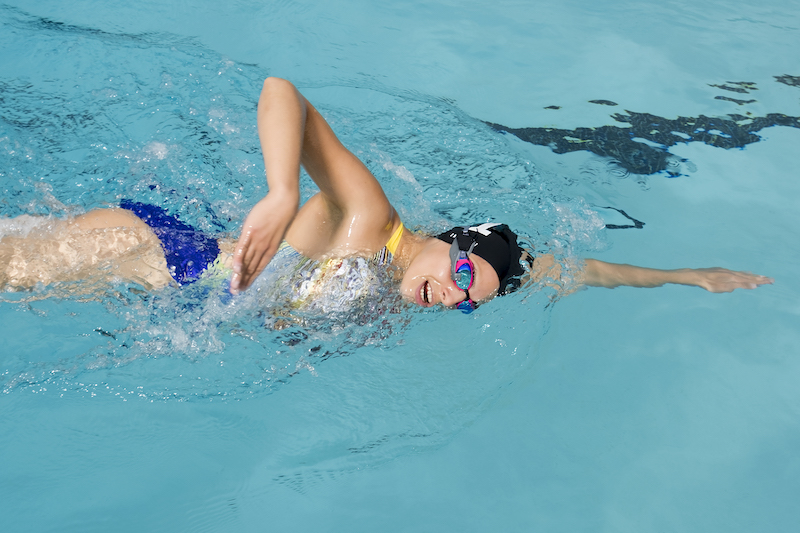Dislaimer: The author of this post is Reine Farhat, LebNet’s Communications Specialist. She has tested both Instabeat products and this is her review]
As someone who personally tested both the old and the new product of Instabeat, I can appreciate the time it took to launch the new version.
Instabeat is a swimming device that gets attached to swim goggles to monitor swimmers’ heart rate in real-time and display the results through color coding on the corner of their goggles. Each of the three colors (green, blue and red) signal a different heart rate range and pushes swimmers to go faster or maintain their pace.
After the swimming session is over, the 27 gram-device takes about 30 seconds to sync with the smartphone application before displaying information about the distance, workouts, the average pace, lap time, peak performance among other data.
The new version of the product was officially launched on July 18, 2019 and can now be ordered from the website.

The reason why founder Hind Hobeika, a competitive swimmer and engineer, wanted to create Instabeat is because when she used to train, she often had to stop her workout for a minute to measure her heart rate – which she calls the most important indicator for enhancing performance. She did not want to use devices like the watch, the belt or the finger clip because they added too much drag to her movement.
I pre-ordered the first version of the product back in 2013 from the crowdfunding platform IndieGoGo and tested it months later. It didn’t fit most of the swim goggles I brought and I honestly wasn’t impressed with the performance: the light wasn’t always working, water was leaking inside my goggles and I had synching problems. I wasn’t the only person facing such issues.
“When we launched the first product, we started too big. We had a crowdfunding campaign, we started shipping and started having many functional and manufacturing problems until it didn’t make sense to keep manufacturing anymore. We decided to stop and start again from scratch,” said Hobeika in an interview with LebNet.
Another mistake Hobeika admitted making was testing the product with Lebanese swimmers only. “Most of the head shapes and swimming styles [in Lebanon] are fairly similar and when we shipped to different countries we understood the complexity of other faces. One of the advantages of being in the US is that it’s so multicultural. In our second testing, we made sure to bring people from different [ethnicities].”

Olympic swimmer Sabine Hazboun using Instabeat.
In 2016, while in London, Hobeika met Jawbone co-founder Alexander Asseily, who worked closely with her on redesigning the product, picking key contractors, building a new team and avoiding previous manufacturing mistakes.
Hobeika and her team approached around 50 manufacturers in the US but none of them had the right machinery, expertise nor were they willing to take a chance on her. She teamed up with a big manufacturer in China but shortly after, the company changed its project manager and its priorities and sadly Instabeat was no longer part of them.
“That’s the problem with working with big partners. You don’t know when their teams and priorities change and when you’re a super small company, you don’t move the needle when it comes to money. When that happened we started looking for smaller manufacturers.”
That’s when Hobeika moved to China to monitor manufacturing closely and get the ball rolling.
“It was hard to look at photos [from the US] and trying to understand what the problem is without testing the product. So I went to China to stay for a week or two, but I saw that everything moves so quickly there.” She would brainstorm the problem with the manufacturing team, go to the pool and test and the next morning try to implement a new solution.
She ended up staying in China for 9 months before the new product was ready to hit the US market again. According to Instabeat’s press release, the development of the product included over 250 swimmers and triathletes including Olympic swimmer Sabine Hazboun and Ironman World Champion Leanda Cave. Testers swam with 11 different swim goggles each – pushing, flipping and turning – confirming the device’s ultra low-weight and low-profile design make it feel nonexistent without sacrificing accuracy. The company has raised a total of $6M in funding to date from Berytech Fund, Wamda Capital, Jabbar Capital, and angel investors. It has spent a total of 8 years on R&D between Lebanon, China and the US.
The product can now be ordered from the website for $249 and shipped within the US in less than 10 days.
From someone who has been familiar with some of the technical issues found in the first version of Instabeat, and who has tested the second one, I am happy to see how Hobeika has come a long way to improve swimmers’ experience and introduce a seamless product that will help them every stroke of the way.
